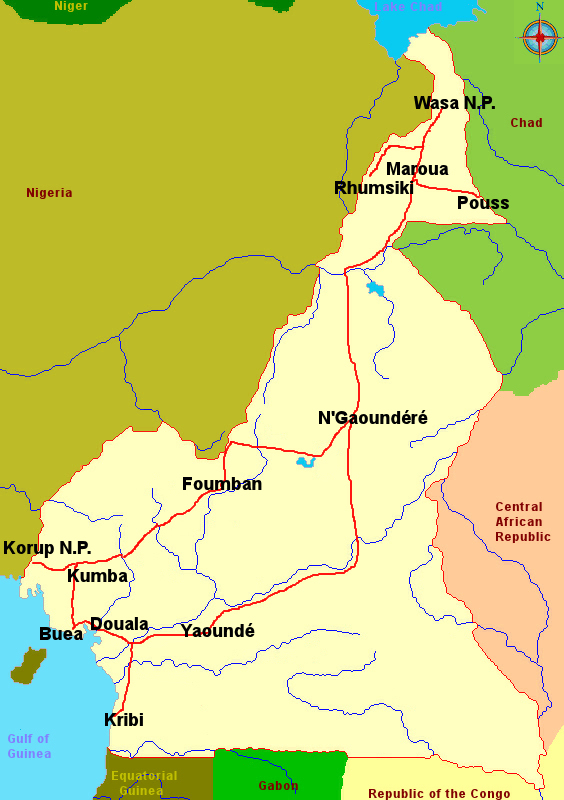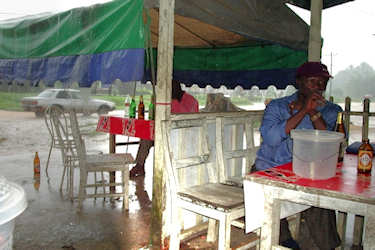Cameroon

Historie
As far back as 8000 BC, the area that is now Cameroon was a meeting point of cultures.
In the south, the original inhabitants were various ethno-linguistic groups of short stature, collectively known as "Pygmies". Beginning
about 2000 years ago, they were gradually displaced by Bantu peoples moving south from present-day Nigeria and the Sahel region, although
large communities still remain.
In Cameroon's extreme north, near Kousséri and Lake Chad, the most significant early culture was that of the Sao people, who migrated from
the Nile Valley. The Sao civilisation flourished from ca. the sixth century BC to as late as the sixteenth century AD.
They are the earliest people to have left clear traces of their presence in the territory of modern Cameroon. Sometime around the 16th century,
conversion to Islam changed the cultural identity of the former Sao.
Today, several ethnic groups of northern Cameroon and southern Chad, but particularly the Sara, Kotoko, claim descent from the
civilization of the Sao.
The first larger, organized society in Cameroon was the Mandara Kingdom, which was founded in the late 15th century AD. Tradition holds that
the kingdom was founded by a female ruler named Soukda. The kingdom warred with neighbors, constantly expanding its territory for the
first 200 years of its existence.
In the early 18th century, the king Mai Bukar Aji was converted to Islam and made the kingdom a sultanate. After a series of successful
wars waged against the Borno kingdom, Mandara’s territory reached an apex around 1800.
The kingdom was weakened by poor rule and antagonistic neighbors until its eventual conquer by German colonists in the late
19th century.
The Kingdom of Bamum (1394–1884) was founded by the Mbum, an ethnic group from northeast Cameroon. Its capital was the ancient walled
city of Fumban.
The economy was largely agricultural, and slave owning was practiced on a small scale. They were not conquerors, and territorial expansion did not
occur until the reign of the tenth Mbum, Mbum Mbuembue, in the early 19th century. He was famous for repelling an attack by the Fulani
in the early 19th century.
Eventually King Njoya, son of the slain king, came to power. He was one of Bamum's most prolific rulers and ruled from approximately 1883
to 1931. He voluntarily put his kingdom under the protection of German colonial power and was responsible for modernizing certain elements of
Mbum society.
In the early 15th century, another important migration occurred when the Fulani (pastoral nomads from Senegal) began to move eastwards.
By the late 16th century, they dominated much of nortcentral Cameroon, adding further to the area's cultural heterogeneity.
In 1472, Portugese explorers sailed up the Wouri River, naming it "Rio dos Camarões" (River of Prawns), thus giving the country its name.
Over the next two centuries, coastal Cameroon became an important port of call for Dutch, Portugese and British slavetraders.
Malaria prevented significant European settlement and conquest of the interior until the mid-19th century, when large supplies of the malaria
suppressant quinine became available.
British influence was curtailed in 1884 when Germany signed a treaty with the well-organised chiefdoms of Douala and the central Bamiléké Plateau,
although for the local inhabitants the agreement meant little more than a shift from one form of colonial exploitation to another.
After WWI, the German Protectorate of Kamerun was carved up between France and Britain - a linguistic and administrative division that marked the
start of a major fault line in the politics of modern Cameroon.
Self-gouvernment was granted in French Cameroon in 1958, followed b-quickly by independence on 1 january 1960.
Ahmadou Ahidjo, leader of the Union Camerounaise independence party and prime minister of the autonomous regions from 1958, became
president of the newly independent state. He held this position until resigning in 1982, ensuring longevity in the interem through the cultivation
of expedient alliances, brutal repression and regional favouritism.
In oktober 1961, the southern section of the Britisch-mandated Cameroon voted to join the newly independent Cameroon Republic in a referendum,
while the northern portion voted to join Nigeria.
In 1982, Ahidjo's hand-picked successor Paul Biya quickly distanced himself from his former mentor, accusing Ahidjo of sponsoring a number
of coups against the new government.
The first multiparty elections in 25 tears were grudgingly held in 1992 and resulted in the Cameroonian Democratic People's Movement - led
by Biya - hanging on to power with the support of minority parties.
Since that time, Biya has clung to power, spending more time in France than Cameroon and leaving his country in its customary state of uneasy
stability and political stagnation.
In the October 1997 presidential election, which was boycotted by the main opposition parties, Biya was re-elected to his second seven-year term
(the constitutional limit).
I visited Cameroon in december 2003
These are the places I have seen on that trip
Douala
Yaoundé
N'Gaoundéré
Maroua
Waza National Park
Pouss
Rhumsiki
Foumban
Kumba
Korup National Park
Buea
Kribi
Please let me know when you're having questions.
i would be pleased to help you.
Things to do and other tips
